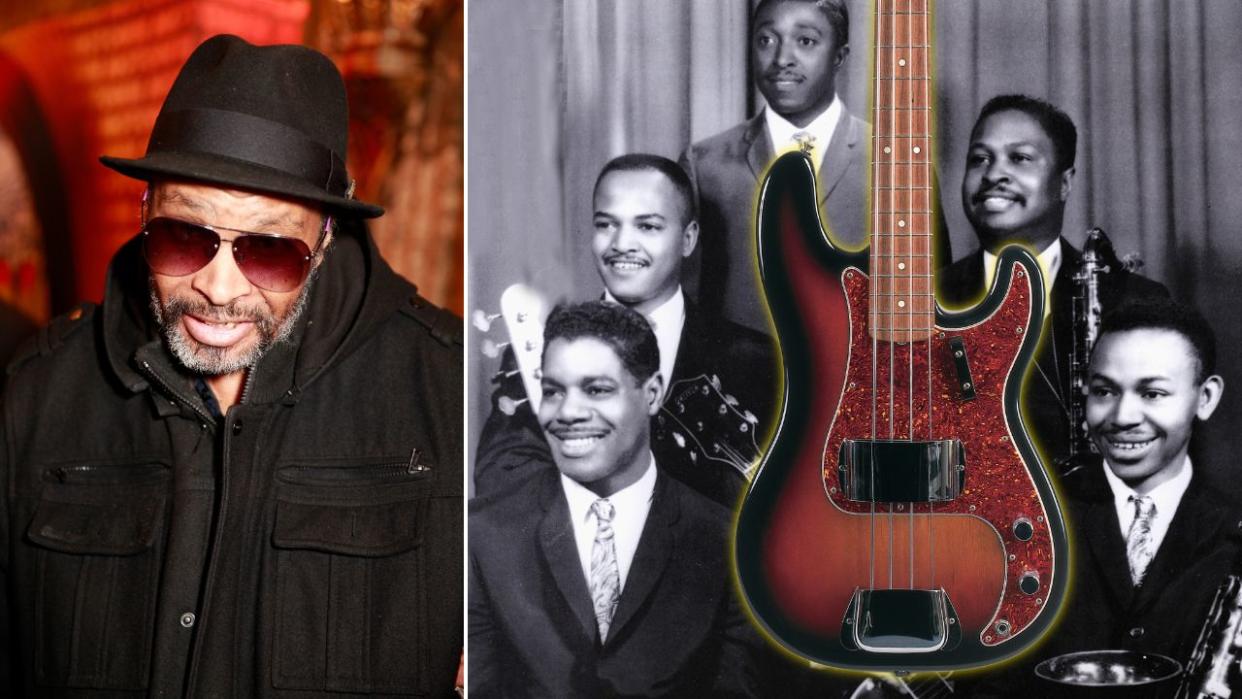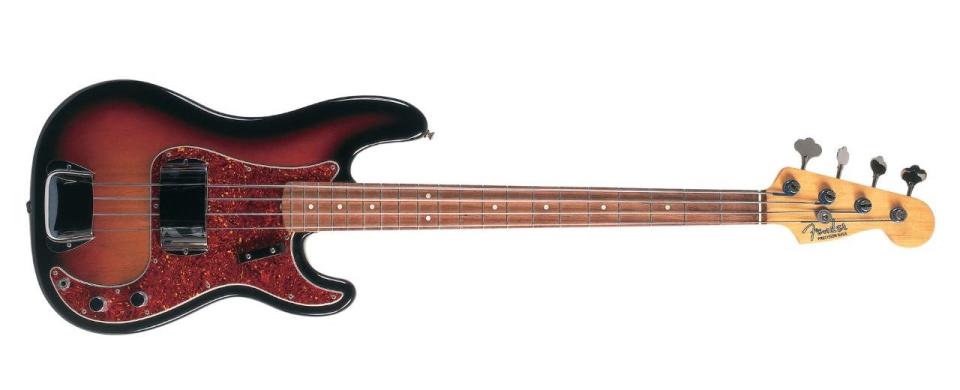Inside the sound and style of Motown master James Jamerson

- Oops!Something went wrong.Please try again later.
There’s a scene in the 2002 film Standing in the Shadows of Motown where Nathan Watts and Ralphe Armstrong take turns lying on their backs in Hitsville's Studio A while playing the bassline from Marvin Gaye's What's Going On, trying to recreate how James Jamerson reportedly recorded his part. It's a fitting image, because Jamerson has been flooring bassists for years.
Unfortunately, mass recognition for the pioneering bass genius didn't come until after his 1983 death at age 47. Six years later, Allan “Dr.Licks” Slutsky's Hal Leonard book/tape package, Standing in the Shadows of Motown: The Life and Music of Legendary Bassist James Jamerson, brought on the first wave of props, culminating in Jamerson's election to the Rock & Roll Hall of Fame in 2000.
A street in his hometown of Edisto Island in South Carolina has since been renamed in his honor. You also voted him number one in our poll to find the 100 greatest bass players of all time.
Born on January 29, 1936, James Lee Jamerson was raised on the sounds of gospel, jazz, and blues radio stations. Following his parents' divorce, his mother relocated from Charleston to Detroit to find work in 1953, sending for James a year later. While attending Northwestern High School, he picked up an acoustic bass in the school's music room and discovered his voice.
He quickly sharpened his skills at jam sessions with Detroit's top jazz musicians and came under the influence of bass heroes like Paul Chambers and Ray Brown. Jamerson got club work in jazz, blues, and R&B nightspots, and before long he was recording for Detroit's labels, including Motown – where he met his future soulmates, the Funk Brothers, in 1959.
In 1961, at the urging of friend and fellow bassist Horace ‘Chili’ Ruth, Jamerson strapped on a Fender Precision. The planets must have been aligned over Detroit that day, as Jamerson quickly took to an instrument he didn't particularly care for at first. Gradually he began applying melodic fills, string-raked walking lines, chromatic passing tones, dizzying syncopations, and other innovations that forged the template for modern electric bass playing.
Unfortunately, as with Jaco Pastorius, James Jamerson's tale has a sad ending. When Motown moved to Los Angeles in 1972, Jamerson followed, but he never quite fit in without his Funk Brothers surrounding him.
Beset with personal problems and plagued by alcoholism, his performance suffered and work slowed. At the time of his death, from a combination of cirrhosis of the liver, heart failure, and pneumonia, he was said to be broke and bitter about his lack of recognition. Had he survived just a few more years, he would have heard the accolades he was due.
Originally published in Bass Player's February 2007 issue, we asked five top low-enders with links to the Motown master to dissect the Jamerson style.
1. Chuck Rainey
“Two ingredients are key to James Jamerson's style. One, he usually played off a root-5th-octave pattern; second, most of the Motown grooves had a hidden baion type of feel. James built many of his lines from the root-5th-octave shape, and then he'd add other scale tones, as well as non-scale chromatic passing tones, to create motion and melodic lines.
“A classic example is what he played on Bernadette by the Four Tops. That was his major influence on my style.”
“Like all great musicians, James heard other things in his head while he played – such as polyrhythms from the drum patterns – and when he added those ideas they came through loud and clear, but they always supported the song.
“Coming from his upright background, James plucked mainly with one finger, using all upstrokes. I remember showing him my back-and-forth index-finger plucking technique, and he laughed and said, ‘that's sissy stuff right there.’”
2. Phil Chen
“The ingredients that made up Jamerson's style were unique. He had Caribbean bloodlines and Deep South roots, and he was influenced by all the musical styles played in Detroit as well as Charlie Parker and other bebop musicians.
“As a result he used half-steps as passing or leading tones, just like a jazz soloist, with the root or chord tone on the strong beat and the chromatic passing note on the weak beat – or as an ear-catching anticipation on the downbeat. It also enabled him to create smooth lines in flat keys.
“Often, he would play two completely different parts in the same song, amazingly creating both out of nowhere. Couple that with the pulsating rhythms of the rest of the Funk Brothers, and the dance floor never stood a chance!
“His stock sunburst '62 P-Bass had a high action and foam under the bridge cover. He used La Bella flat-wounds, gauges .052-110, that he rarely changed. You can still buy the same-gauge set; they have blue silk windings on the ends.”
3. Ralphe Armstrong
“James Jamerson was the consummate blend of intellectual, trained musician and street-smart player. His concept was to play music with feeling and tone, and he was harmonically aware of every note he played.
“A key to his sound was his use of an upright technique that dates back to Domenico Dragonetti and was used by Charles Mingus and Ray Brown: Instead of laying his fingers across the string, which is a more legato approach, he would anchor his left thumb behind the neck and curve his fingers so only the tips were touching the target notes.
“This violin-like technique, still common with European double bassists, enables you to get a pure note. He stayed fairly faithful to upright fingering by using his 3rd finger on top of his 4th to help hold down a note, or sometimes just squeezing the two together.
“He played mostly in 1st position and used a lot of open strings to help him facilitate shifts in flat keys, which became a trademark part of his sound. He also loved to drop down from the root to the 3rd, which you can hear on the Gladys Knight version of Grapevine, among many others.”
4. Bob Babbitt
“I learned three important lessons from Jamerson. First, feel is the most important thing. You can play two notes or 22 notes, but it has to feel good. Listen to what James plays on Smokey Robinson's My Girl – it's only three notes, but he plays them with such feel that it's a major hook. Stevie Wonder's I Was Made to Love Her has a lot of notes, but the feel is just as prominent.
“Second is freedom of expression; James went a step beyond what bassists normally do. At first he took chances and let himself go, and then it just became natural for him, and in the process he changed the course of bass playing. That was very inspirational for me.
“Third, he told me to always make your bass sing like a voice. He felt the bass should have its own voice. That led him to play melodically on even the most fundamental 1st-position parts.”
“A lot of Jamerson's syncopation came from his magical relationship with Benny Benjamin; they'd play off each other and do call-and-answer stuff. He'd hit the one with Benny and then wait until Benny played his next kick beat, and then James would answer that with a figure. Or he'd play counter to the drums, like on Martha & the Vandellas' Heat Wave. Everyone is playing the dotted-quarter-to-an-eighth-note, Charleston-type of feel, and he plays a walking line against it.
“James always played with authority and conviction, but he had a lighter, more-relaxed touch than people think. That's how he was able to play with such grace. Ultimately, Jamerson gave his total being to a track. That's why he's the master.”
5. James Jamerson Jr.
“A lot of my dad's style came from his personality, and he had a different personality and approach for each Motown artist. He had the ballad style with Smokey Robinson; with Marvin Gaye he was more melodic; with Stevie Wonder he was able to stretch more; with the Temptations it was a low, resonant kind of sound – but all of it was still his style. And what amazed me was that early on there were only chord charts with no arrangements of notation, so he’d just go, ‘Who is this for?’ and play accordingly.
“He played a lot of ghost-notes, but back then the term didn't mean dead notes – it referred to notes that would hang in the air after the chord moved to the next change. Usually, it would be an open E or A phrased a certain way in a flat key. And because it was on the bottom, it would really throw people and trick the ear, because you couldn't distinguish what had just happened.
“As for his sense of syncopation, that was his God-given gift. I couldn't even explain that one. I put it like this: My dad liked to dance, so he just danced on the bass. He was a staunch acoustic bassist, and he made me learn the upright before I was allowed to play electric bass, but he grew to like both instruments.”

“He would occasionally polish his P-Bass, but he'd never touch the gunk that had built up on the fingerboard. He told me, ‘The dirt keeps the funk.’
“One thing I'm grateful for, both personally and for my dad, was a recording date I did in L.A. for Robert Goulet. It was my first major session, and I was filling in for my dad, who was ill. Afterward, the arranger, Bruce Miller, sent my father a letter saying what a good job I had done and how I had lived up to my name. I came home and saw my dad reading the letter and crying.
“He gave me a big hug and said, ‘You've done your daddy justice.’ It made him so proud that someone was carrying on his legacy, and that it was one of his own.”

